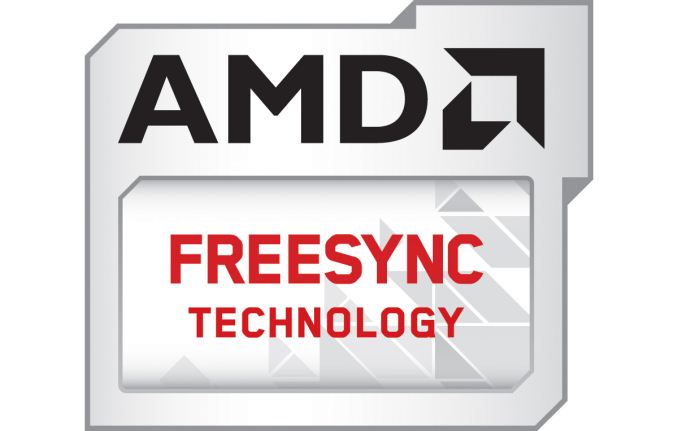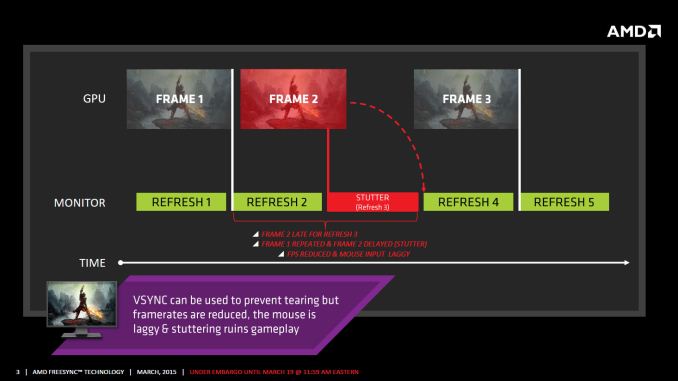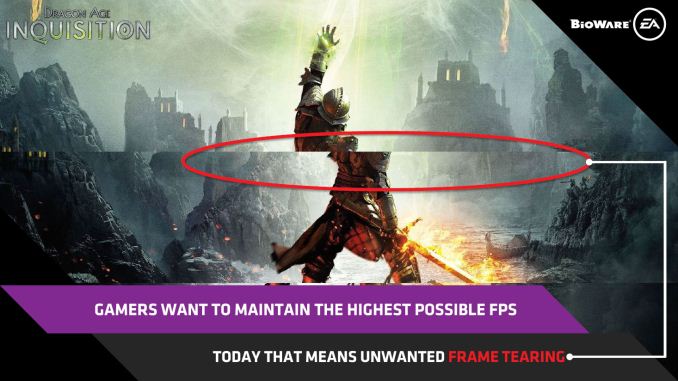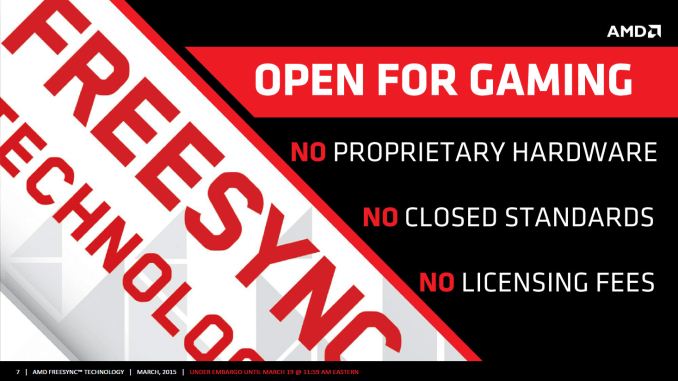The AMD FreeSync Review
by Jarred Walton on March 19, 2015 12:00 PM EST
Introduction to FreeSync and Adaptive Sync
The first time anyone talked about adaptive refresh rates for monitors – specifically applying the technique to gaming – was when NVIDIA demoed G-SYNC back in October 2013. The idea seemed so logical that I had to wonder why no one had tried to do it before. Certainly there are hurdles to overcome, e.g. what to do when the frame rate is too low, or too high; getting a panel that can handle adaptive refresh rates; supporting the feature in the graphics drivers. Still, it was an idea that made a lot of sense.
The impetus behind adaptive refresh is to overcome visual artifacts and stutter cause by the normal way of updating the screen. Briefly, the display is updated with new content from the graphics card at set intervals, typically 60 times per second. While that’s fine for normal applications, when it comes to games there are often cases where a new frame isn’t ready in time, causing a stall or stutter in rendering. Alternatively, the screen can be updated as soon as a new frame is ready, but that often results in tearing – where one part of the screen has the previous frame on top and the bottom part has the next frame (or frames in some cases).
Neither input lag/stutter nor image tearing are desirable, so NVIDIA set about creating a solution: G-SYNC. Perhaps the most difficult aspect for NVIDIA wasn’t creating the core technology but rather getting display partners to create and sell what would ultimately be a niche product – G-SYNC requires an NVIDIA GPU, so that rules out a large chunk of the market. Not surprisingly, the result was that G-SYNC took a bit of time to reach the market as a mature solution, with the first displays that supported the feature requiring modification by the end user.
Over the past year we’ve seen more G-SYNC displays ship that no longer require user modification, which is great, but pricing of the displays so far has been quite high. At present the least expensive G-SYNC displays are 1080p144 models that start at $450; similar displays without G-SYNC cost about $200 less. Higher spec displays like the 1440p144 ASUS ROG Swift cost $759 compared to other WQHD displays (albeit not 120/144Hz capable) that start at less than $400. And finally, 4Kp60 displays without G-SYNC cost $400-$500 whereas the 4Kp60 Acer XB280HK will set you back $750.
When AMD demonstrated their alternative adaptive refresh rate technology and cleverly called it FreeSync, it was a clear jab at the added cost of G-SYNC displays. As with G-SYNC, it has taken some time from the initial announcement to actual shipping hardware, but AMD has worked with the VESA group to implement FreeSync as an open standard that’s now part of DisplayPort 1.2a, and they aren’t getting any royalties from the technology. That’s the “Free” part of FreeSync, and while it doesn’t necessarily guarantee that FreeSync enabled displays will cost the same as non-FreeSync displays, the initial pricing looks quite promising.
There may be some additional costs associated with making a FreeSync display, though mostly these costs come in the way of using higher quality components. The major scaler companies – Realtek, Novatek, and MStar – have all built FreeSync (DisplayPort Adaptive Sync) into their latest products, and since most displays require a scaler anyway there’s no significant price increase. But if you compare a FreeSync 1440p144 display to a “normal” 1440p60 display of similar quality, the support for higher refresh rates inherently increases the price. So let’s look at what’s officially announced right now before we continue.













350 Comments
View All Comments
Hrel - Thursday, March 19, 2015 - link
I'm so sick of this proprietary shit, when companies want to do something new why not work with the other companies in the industry to come up with the best solution for the problem and make it universal? Customers NEVER jump onto a technology that only works from one company, we aren't going to commit to a monopoly. I get that they want a competitive edge in the market, but it literally never works that way. What happens is they spend all this money on R&D, marketing, prototyping, waste everyone's time with marketing and reviews only to have a handful of people pick it up (probably too few to even break even) and then it stops growing right there until a universal standard comes out that the industry adapts as a whole.Just fucking stop wasting everyone's time and money and choose cooperation from the start!
HunterKlynn - Thursday, March 19, 2015 - link
For the record, AMDs solution here *is* an attempt at an open standard. GSync is the proprietary one.dragonsqrrl - Thursday, March 19, 2015 - link
...Black Obsidian - Thursday, March 19, 2015 - link
It's hard to be more open than being an official (albeit optional) part of the DisplayPort spec itself.DominionSeraph - Thursday, March 19, 2015 - link
I'm sure AMD will be happy to give you the masks to the 290X and 390X, if you only ask. "I'm sick of there only being two players in the market. Why don't you let me in? I'm sure I could sell your products for less than your prices!"lordken - Thursday, March 19, 2015 - link
next time when you try to make someone look stupid, try no to look like fool by yourself. Another dogma believer that thinks without patents world will end. Same as copyright believers that music&entertainment without copyright will stop to exist...If you think about it, you can see that patents can actually pretty much slow down technology advancement. You can even see that today with Intel CPUs, as AMD cannot catch up and CPUs are patent locked we are left to be milked by Intel with minimal performance gains between generations. If either AMD would have better CPUs or could simply copy good parts from Intel and put into their design today, imho, we would be much far with performance. Also look around you and see that 3D printing boom? Guess what few years back and last year patents expired and allowed this. Yes 3D printing was invented 30years ago, yet it gets to your desk only today. So much for patent believers.
btw even if AMD would give you their blueprints what would you do? Start selling R390X tomorrow right? Manufactured out of thin air. By the time you could sell R390X we would be at 590 generation. Possibly only nvidia/intel would be able to benefit that sooner (which isnt necesarily a bad thing)
lordken - Thursday, March 19, 2015 - link
@Hrel: a) cause most corporations are run by greedy bastards imho b) today managers of said corporations cant employ common sense and are disconnected from reality making stupid/bad decisions. I see it in big corporation i work for...so using brain and "pro-consumer" way of thinking is forbidden.
Flunk - Thursday, March 19, 2015 - link
Please just support the Adaptive VSync standard Nvidia, your G-Sync implmentation doesn't have any benefits over it. You don't need to call it FreeSync, but we all need to settle on one standard because if I have to be locked in to one brand of GPU based on my monitor isn't not going to be the one that's not using industry standards.Murloc - Thursday, March 19, 2015 - link
a monitor lasts much longer than a GPU and costs more too for most users out there so yeah, standards win.They can call it adaptive sync as that's what it is. A Displayport standard.
praeses - Thursday, March 19, 2015 - link
It would be interesting to see input lag comparisons and videos of panning scenes in games that would typically cause tearing captured at higher speed played in slow motion.